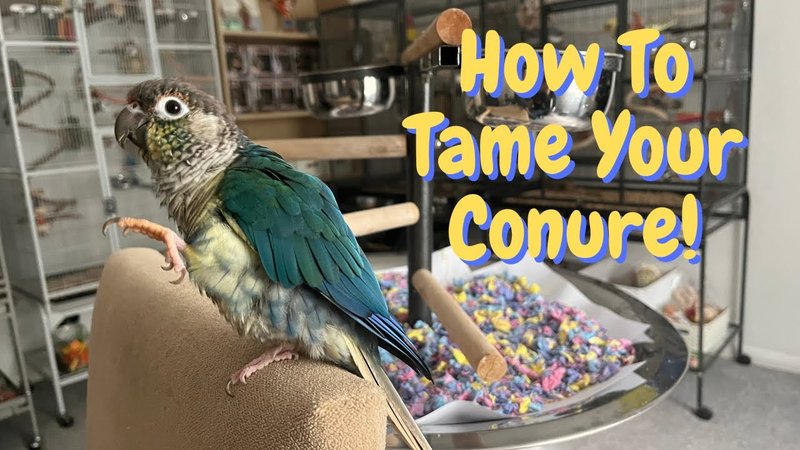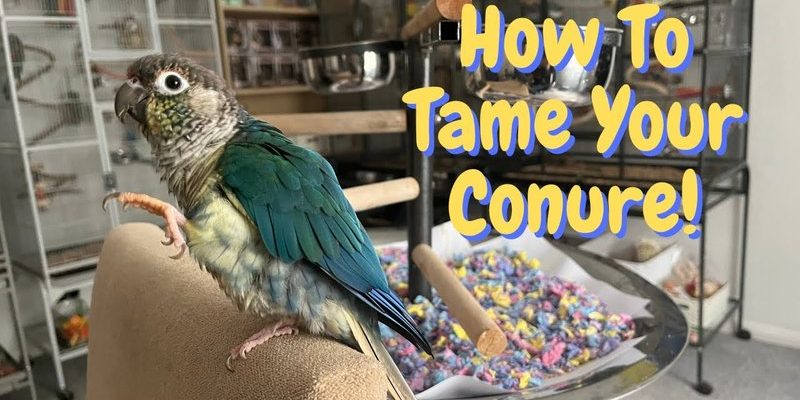
Taming and bonding with your conure isn’t just about getting them comfortable around you; it’s about creating a trusting relationship that can last a lifetime. Imagine hosting a new friend for coffee—you wouldn’t rush them into sharing secrets. Instead, you’d talk, laugh, and slowly peel back the layers of each other’s personalities. That’s how you should approach bonding with your conure. In this guide, we’ll explore practical tips and techniques to ensure that your conure feels safe and loved, paving the way for a beautiful friendship.
Understanding Your Conure’s Personality
Every conure has its own unique personality, much like humans. Some may be shy and reserved, while others are bold and outgoing. Before diving into taming techniques, it’s vital to *understand your conure’s character*. Spend time just observing them. Notice how they react to various stimuli: the sounds in their environment, your presence, and even the changes in their routine.
Conures, being social creatures, thrive on interaction. They often enjoy physical touch, playful banter, and sometimes even a goofy little dance. If your conure hides or shrinks away, they might need a bit more time to warm up to you. Here’s a tip: you might find that offering treats can help. Use fruits or seeds they love to establish a connection slowly. This way, you’re not only meeting their needs but also making them associate you with positive experiences.
It’s also essential to recognize that conures can have moods, just like us. If they seem grumpy or uninterested, don’t force interaction. Give them space and return when they seem more receptive. Over time, you’ll get to know your conure’s likes, dislikes, and quirks, which is all part of the bonding process.
Creating a Safe Environment
Just like we feel more relaxed in a cozy home, your conure needs a safe and welcoming environment to flourish. If they’ve just moved into your space, they might be a bit anxious. Setting up their space is the first step.
* Start with a well-sized cage that allows them to move around freely. Add some perches, toys, and hiding spots. Birds love to explore, so making their space stimulating can help ease their nerves.
* Make sure the cage is situated in a quiet part of your home, away from loud noises or commotion. Over time, you can gradually introduce them to busier areas as they become more confident.
Routine is also crucial. Birds thrive on predictable schedules. Try to stick to consistent feeding and interaction times. This will help your conure understand when to expect your presence and feel secure, knowing what comes next.
Lastly, ensure safety by keeping their environment free from hazards. Remove toxic plants, cover any cables, and secure windows. A safe environment lays the groundwork for trust, helping your conure feel secure in their new home.
Building Trust Through Interaction
Now that you’ve set the stage for a comfortable environment, it’s time to foster trust through interaction. Start slowly. Your goal is to make your conure comfortable with your presence.
One effective method is to talk softly to your conure. You might be wondering if they even understand you. While they might not comprehend your words, they pick up on your tone and energy. Just like a child remembers soothing words from a parent, your conure will begin to associate your voice with safety and warmth.
Another great way to bond is through *target training*. This nifty technique involves using a stick or your finger as a target for your bird to touch or follow. Start by letting them touch the stick and gradually rewarding them with a treat. This approach not only captures their interest but builds a positive association with you.
Remember to be patient. Some days might feel more challenging than others. If your conure is skittish, take a break and try again later. Bonding is a journey, not a race.
Using Positive Reinforcement
Positive reinforcement is your best friend when it comes to taming and bonding with your conure. Essentially, this means rewarding desired behaviors to encourage them to repeat those actions. Think of it as a fun game rather than a chore!
When your conure approaches you or interacts in a way you like, offer a little treat or praise. Here’s how to do it effectively:
- Wait for moments when your conure does something you appreciate—like stepping onto your finger—then immediately reward them.
- Keep treats handy and easily accessible during training sessions. It helps to have small bits of their favorite snacks ready.
- Use a consistent cue word or phrase when giving a treat, like “good bird!” This helps them connect the action with the reward.
The beauty of this method is that it not only reinforces good behavior but also creates an enjoyable bonding experience. Over time, your bird will start to look forward to interaction, eagerly anticipating those treats and your companionship.
Spending Quality Time Together
The bond you create with your conure will thrive on *quality time*. Simply put, the more time you spend together, the stronger that connection becomes. Here are some practical ideas to make the most of your time:
– Playtime: Conures love to play! Offer toys they can chew, climb on, and interact with. You can even set aside specific playtime on your shoulder. Just be sure to supervise closely.
– Training Sessions: Incorporate short training sessions into your routine. Not only does this foster trust, but it also taps into their natural curiosity and intelligence.
– Quiet Time: Sometimes, just sitting nearby while your conure chats away can be comforting for them. They might not always want active engagement, and that’s perfectly fine.
As you share these moments, try to be aware of their mood and preferences. If they seem to grow tired or cranky, give them space. The goal is to create enjoyable experiences that deepen your connection, making both of you eager for more shared activities.
Recognizing and Addressing Behavioral Challenges
As with any relationship, you may face some behavioral challenges along the way. Common issues include biting, screaming, or screaming for attention. Addressing these challenges early can keep your bond healthy and strong.
If your conure bites, it might be a sign of fear or discomfort. Understanding the cause is crucial. Here’s how to handle it:
– Avoid sudden movements: Conures can be easily startled. Approach them slowly, and let them come to you instead of lunging at them.
– Provide distractions: If they seem bored or agitated, offer new toys or activities to spark their interest and redirect their energy.
For vocalization, remember that conures can be quite chatty! If the noise gets too much, try reinforcing quieter behaviors instead of punishing loud ones. Reward them when they’re calm, giving them the message that quiet moments are appreciated.
If you find certain behaviors are particularly challenging, don’t hesitate to seek advice from an avian veterinarian or a bird behaviorist. They can provide tailored guidance to help you and your conure thrive together.
Celebrating Your Bond
As you progress through taming and bonding with your conure, it’s vital to celebrate your achievements, no matter how small. Each step toward gaining their trust is a victory. Perhaps they nibbled on your finger or gave you a sweet chirp. Recognize these moments—this is the foundation of your relationship!
Consider keeping a little journal of your experiences. Write down new tricks they learn or sweet moments you share. This not only tracks progress but also allows you to go back and reflect on how far you’ve come together.
In the end, taming and bonding with your conure is about patience, understanding, and each other’s quirks. With love and commitment, your feathered friend will become a cherished part of your life, filling your days with joy, laughter, and companionship.
By following these steps, you’re setting the stage for a wonderful journey with your conure, leading to a bond that’s rich, rewarding, and truly special. So grab those treats, take a deep breath, and enjoy the process—you’re in for an amazing adventure!

